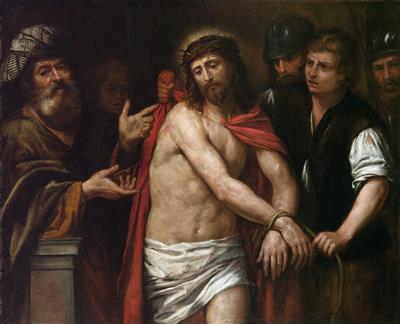Domenico Fiasella, il Sarzana

(Sarzana 1589–1669 Genoa)
Ecce Homo,
oil on canvas, 108.7 x 133.3 cm, framed
Provenance:
European private collection
We are grateful to Professor Camillo Manzitti for confirming the attribution after examining the painting in the original (written communication).
Manzitti has dated this previously unpublished painting to Fiasella´s late period.
The present composition can be related to another painting of the same subject realized by the Tuscan painter Ludovico Cigoli at the beginning of the 17th century. The influence of Cigoli on Domenico Fiasella during his time in Rome (1607/8-1615) is evident and Cigoli had executed his Ecce Homo for the Massimo family, related to Vincenzo Giustiniani, who was Fiasella´s most important patron during the Roman sojourn.
Unlike the various versions of the subject painted by his Genoese colleagues, Fiasella leaned towards a more sober interpretation of the event, characterized by a formal elegance. According to Manzitti, the accurate anatomy of the body of Christ, is modeled with precision similar to the work of Guido Reni. The refined delicacy of the brushwork of the loincloth, together with the gestures of the protagonists display the influence of Bolognese classicism.
Fiasella, the son of a silversmith, studied briefly with Aurelio Lomi (1556–1622) and then with Giovanni Battista Paggi in Genoa. Around 1607 he left for Rome, where he stayed for about ten years, before returning to Sarzana, perhaps in 1616 when he painted the altarpiece for the church of Saint Lazzaro in his native town. Between 1616 and 1618 he settled in Genoa. A painter of broad pictorial culture, Fiasella re-elaborated during his career the various influences absorbed by the reformed Tuscan artists, the followers of Caravaggio in Rome, and the Genoese culture of the beginning of the 17th century
15.10.2013 - 18:00
- Odhadní cena:
-
EUR 30.000,- do EUR 40.000,-
Domenico Fiasella, il Sarzana
(Sarzana 1589–1669 Genoa)
Ecce Homo,
oil on canvas, 108.7 x 133.3 cm, framed
Provenance:
European private collection
We are grateful to Professor Camillo Manzitti for confirming the attribution after examining the painting in the original (written communication).
Manzitti has dated this previously unpublished painting to Fiasella´s late period.
The present composition can be related to another painting of the same subject realized by the Tuscan painter Ludovico Cigoli at the beginning of the 17th century. The influence of Cigoli on Domenico Fiasella during his time in Rome (1607/8-1615) is evident and Cigoli had executed his Ecce Homo for the Massimo family, related to Vincenzo Giustiniani, who was Fiasella´s most important patron during the Roman sojourn.
Unlike the various versions of the subject painted by his Genoese colleagues, Fiasella leaned towards a more sober interpretation of the event, characterized by a formal elegance. According to Manzitti, the accurate anatomy of the body of Christ, is modeled with precision similar to the work of Guido Reni. The refined delicacy of the brushwork of the loincloth, together with the gestures of the protagonists display the influence of Bolognese classicism.
Fiasella, the son of a silversmith, studied briefly with Aurelio Lomi (1556–1622) and then with Giovanni Battista Paggi in Genoa. Around 1607 he left for Rome, where he stayed for about ten years, before returning to Sarzana, perhaps in 1616 when he painted the altarpiece for the church of Saint Lazzaro in his native town. Between 1616 and 1618 he settled in Genoa. A painter of broad pictorial culture, Fiasella re-elaborated during his career the various influences absorbed by the reformed Tuscan artists, the followers of Caravaggio in Rome, and the Genoese culture of the beginning of the 17th century
|
Horká linka kupujících
Po-Pá: 10.00 - 17.00
old.masters@dorotheum.at +43 1 515 60 403 |
| Aukce: | Obrazy starých mistr? |
| Typ aukce: | Salónní aukce |
| Datum: | 15.10.2013 - 18:00 |
| Místo konání aukce: | Wien | Palais Dorotheum |
| Prohlídka: | 05.10. - 15.10.2013 |
